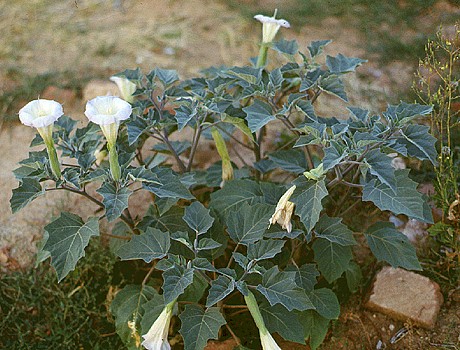
Synonymy
*Datura wrightii Regel, Gartenfl. 8: 193, t. 260 (1859)
T: Described from Texas, North America, C. Wright 526; neo: US, n.v., fide A.S. Barclay, Bot. Mus. Leafl. 18: 254 (1959).
Description
Annual herb, tomentose with retrorse, non-glandular hairs and some erect, glandular hairs.
Mature leaves ovate to angularly ovate, the lamina up to 16 cm long and 10 cm wide, entire or irregularly lobed.
Calyx 6–9 cm long, 5–lobed; lobes 10–25 mm long, sometimes incompletely separated. Corolla 14–20 cm long, white, usually tinged with lavender towards margin, 5–lobed; lobes ending in slender point 5–13 mm long. Stamens shortly exserted; anthers 10–14 mm long. Style 15–17 cm long; stigma above level of anthers.
Capsule globose, to 3.5 cm diam., deflexed, spiny; spines numerous, sharp, all about equal in length, usually 3–5 mm long; persistent base of calyx to 10 mm long, prominent. Seeds 5–6 mm long, yellow-brown to grey-brown.
Distribution and ecology
Occurs naturally in California, Mexico, and western Texas. Occasionally grown as an ornamental.
Uncommon garden escape in N.S.W., Vic., S.A., and W.A.
Common name
Sacred thorn-apple (US), Hairy Thornapple, Jimsonweed (US).
Notes
A variable species; leaf margin, style length and spine length occasionally approach those of D. inoxia Miller with which it has sometimes been misidentified under the name D. metel L. Occasionally called D. meteloides DC. ex Dunal in early literature.
Selected specimens
W.A.: Northam, Royce 5675 (PERTH). N.T.: Alice Springs, P.K. Latz 6722 (NT). S.A.: Mannum, D.E. Symon 1942 (ADW). N.S.W.: Finley, D.E. Symon 9804 (NSW). Vic.: Yarrawonga, Mar. 1953, R.H. Nation (MEL).
Derivation of epithet
Named for 19th century American botanist Charles Wright (1811-1885), who collected plants in America as well as other parts of the world and was involved in early expeditions such as the U.S. North Pacific Exploring Expedition.
Images and information on web
The Datura and Brugmansia Society has images of various life stages of this species on its site: see www.abads.net/datura/wrightii/
There are also numerous images of this species in the Image Gallery for Datura of the United State Department of Agriculture (USDA), on the CalPhotos website and on the Arizona Wild flowers site at www.delange.org/Jimson/Jimson.htm
Further information can be found on the Weeds in Australia site.
Further information about the toxic properties of this plant can be found with a search in theFDA Poisonous Plant Database
Plant status (if any)
General information about Datura species as declared plants in
All species of Datura are declared in Western Australia, Tasmania and Northern Territory while D. ferox, D. inoxia and D. stramonium are included in Victorian legislation.
Information on the occurrence and declaration of Datura in
A fact sheet for this species can be downloaded from the SA eFlora site.



